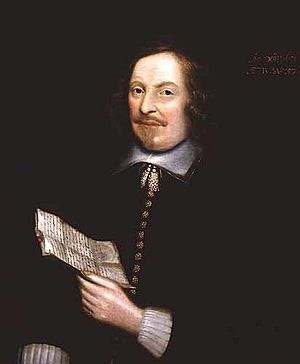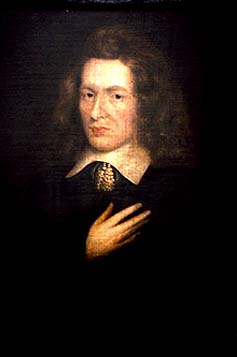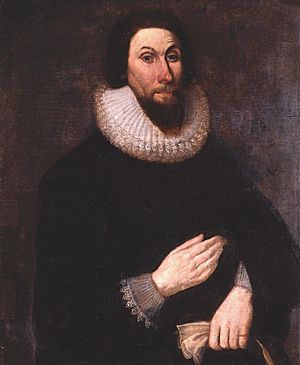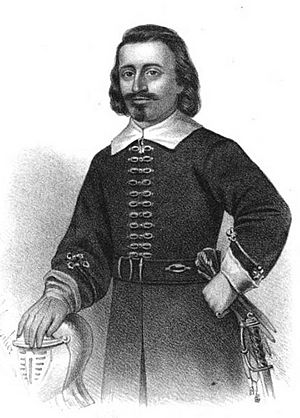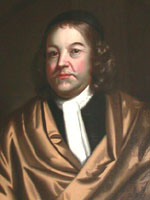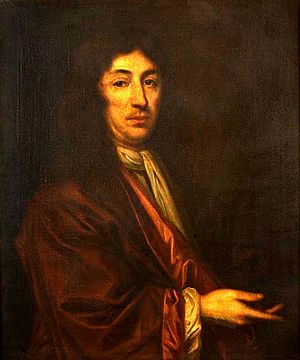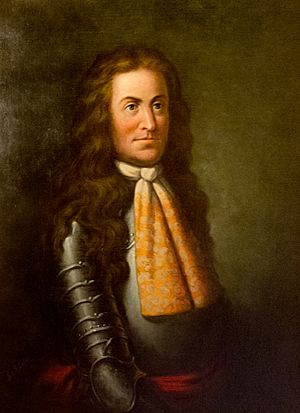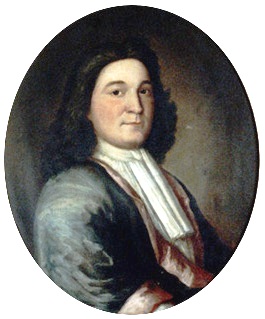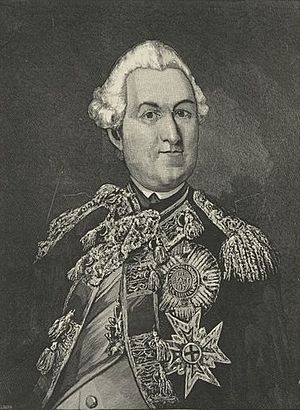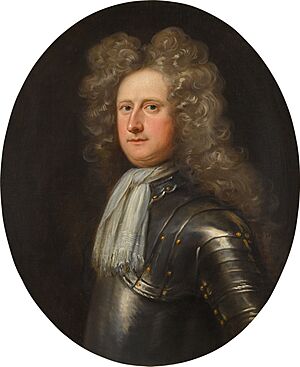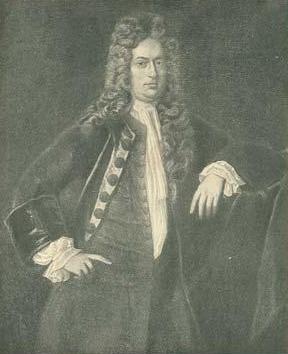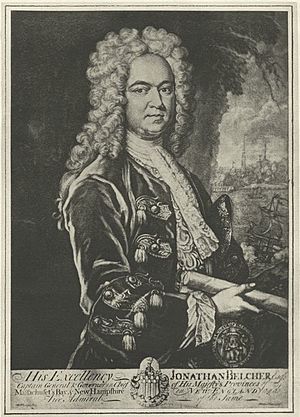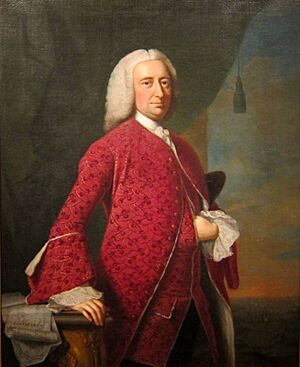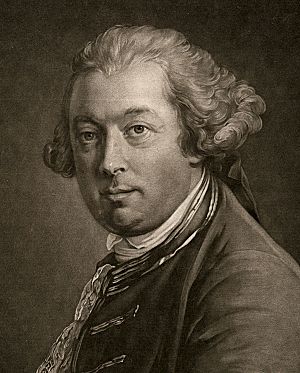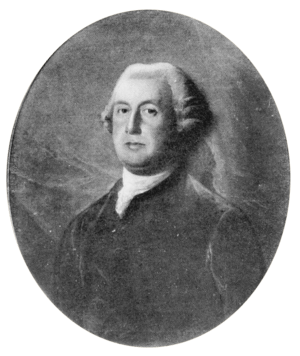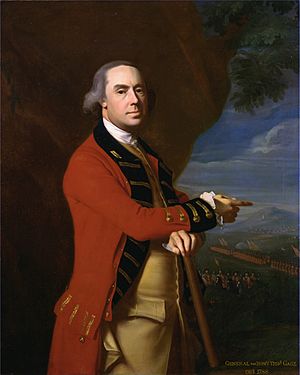List of colonial governors of Massachusetts facts for kids
The area that is now the state of Massachusetts was first settled in the 1600s by several English colonies. These colonies sometimes claimed much larger areas than Massachusetts today, even including parts of other New England states and Canadian provinces like New Brunswick and Nova Scotia. Some claims even stretched all the way to the Pacific Ocean!
The first lasting settlement was the Plymouth Colony in 1620. Another big settlement was the Massachusetts Bay Colony at Salem in 1629. Some colonies didn't last long or joined others, like the Popham Colony (1607) in Maine, and the Wessagusset Colony (1622–23) in Weymouth, Massachusetts, which later joined Plymouth.
Plymouth and Massachusetts Bay colonies existed side-by-side until 1686. Each year, they elected their own governors. A small group of leaders, called magistrates, often ran things for many years. In 1686, the Dominion of New England was created. This new government took over the land of these colonies, plus New Hampshire, Connecticut, and Rhode Island. Later, it also included New York and East and West Jersey. The colonists really disliked the Dominion. It ended in 1689 when its governor, Sir Edmund Andros, was arrested and sent back to England. This happened after the Glorious Revolution in England in 1688.
After Andros was arrested, the colonies went back to their old ways of governing. But King William III changed things. He combined the Plymouth and Massachusetts Bay colonies into the Province of Massachusetts Bay in 1692. He appointed Sir William Phips as its royal governor. The Province of Massachusetts Bay had governors appointed by the King until 1774. That's when Thomas Hutchinson was replaced by General Thomas Gage. This was a time of growing tension between the Thirteen Colonies and the British government. Gage was the last royal governor. He had little power outside Boston and was called back to England after the Battle of Bunker Hill in 1775. By then, the Massachusetts Provincial Congress was already running the area. After a new state constitution was created in 1779, the new Commonwealth of Massachusetts elected John Hancock as its first governor.
Contents
- Early Colonial Settlements in Massachusetts
- Popham Colony: A Short Stay (1607–1608)
- Plymouth Colony: The Pilgrims' Home (1620–1692)
- Wessagusset Colony: A Very Short Experiment (1622–1623)
- Governor-General of New England: Robert Gorges (1623–1624)
- Massachusetts Bay Colony: A Strong Puritan Settlement (1629–1692)
- Dominion of New England: Royal Control (1686–1689)
- Province of Massachusetts Bay: Royal Governors (1692–1775)
- More About Massachusetts History
Early Colonial Settlements in Massachusetts
Popham Colony: A Short Stay (1607–1608)
The Popham Colony was started in 1607 on the coast of Phippsburg, Maine. It was an attempt by the Virginia Company of Plymouth to create a settlement. The colony only lasted about one year before everyone left. One of its main supporters was Sir John Popham. His nephew, George Popham, was the colony's governor for most of its short life. George Popham died there in 1608. Raleigh Gilbert took over, but he and the remaining colonists left when they heard that John Popham and Gilbert's brother had also died.
| Governor | Started office | Left office |
|---|---|---|
| George Popham | 1607 | February 1608 |
| Raleigh Gilbert | February 1608 | September 1608 |
Plymouth Colony: The Pilgrims' Home (1620–1692)
The Plymouth Colony began with a land grant from the London Virginia Company. This grant was for a group of English Puritans who had gone to Holland to escape religious unfairness. They sailed to the New World in 1620 on the Mayflower. Their trip was paid for by the Merchant Adventurers. These investors sent more settlers to make money in the colony.
The settlers planned to build their colony near the Hudson River. But bad weather led them to land instead at Plymouth, Massachusetts, on Cape Cod Bay. The colonists got a land grant from the Plymouth Council for New England in 1621. However, their early government followed the rules of the Mayflower Compact. This was a document they wrote and signed on the Mayflower before they even landed. In 1630, the colony received a formal charter from the Plymouth Council. This gave them the power to govern. But they couldn't get a royal charter from the King. This would have protected their land from other groups.
The colony held elections for its leaders every year. From 1620 to 1680, a governor ruled. If the governor left, he would name a temporary replacement. In 1681, they started electing a deputy governor. This person would serve when the governor was away. William Bradford was a very important leader. He served as governor for more than 30 terms.
The colony became part of the Dominion of New England in 1686. But the Dominion was ended in 1689. All the New England colonies temporarily went back to their old governments. Plymouth finally got a royal charter in 1691. But it wasn't the one they had wanted for 70 years. Instead of keeping Plymouth independent, the charter made it part of the Province of Massachusetts Bay. This new setup began in 1692 when the royal governor, Sir William Phips, arrived.
| Governor | Started office | Left office | Deputy governor |
|---|---|---|---|
| John Carver | November 11, 1620 | died April 15, 1621 | Plymouth had no deputy governors until 1681. The governor named a temporary governor when he was absent. |
| William Bradford | May 1621 | January 1, 1633 | |
| Edward Winslow | January 1, 1633 | March 27, 1634 | |
| Thomas Prence | March 27, 1634 | March 3, 1635 | |
| William Bradford | March 3, 1635 | March 1, 1636 | |
| Edward Winslow | March 1, 1636 | March 7, 1637 | |
| William Bradford | March 7, 1637 | June 5, 1638 | |
| Thomas Prence | June 5, 1638 | June 3, 1639 | |
| William Bradford | June 3, 1639 | June 5, 1644 | |
| Edward Winslow | June 5, 1644 | June 4, 1645 | |
| William Bradford | June 4, 1645 | died May 9, 1657 | |
| Thomas Prence | June 3, 1657 | June 3, 1673 | |
| Josiah Winslow | June 3, 1673 | December 18, 1680 | |
| Thomas Hinckley | December 18, 1680 | 1686 | James Cudworth (1681–82) |
| William Bradford the Younger (1682–86) | |||
| Dominion of New England | 1686 | 1689 | Not applicable |
| Thomas Hinckley | 1689 | 1692 | William Bradford the Younger (1689–92) |
Wessagusset Colony: A Very Short Experiment (1622–1623)
The Wessagusset Colony was a trading colony in Weymouth, Massachusetts. It was also called the Weston Colony or Weymouth Colony. About 55 colonists settled there in August 1622. They were not ready for colonial life and didn't have enough supplies. The colony ended in late March 1623. The colonists who survived either joined the Plymouth Colony or went back to England.
| Governor | Started office | Left office |
|---|---|---|
| Richard Greene | April 1622 | died around October 1622 |
| John Sanders | around October 1622 | March 1623 |
Governor-General of New England: Robert Gorges (1623–1624)
In 1623, King Charles I appointed Robert Gorges as Governor-General of New England. His job was to oversee Plymouth, Wessagusset, and any future colonies in New England. Gorges started a small colony where the Wessagusset Colony had failed. His effort ended after one year because of money problems. Some of his settlers stayed in the area without a formal government. They moved to places like the Shawmut Peninsula, which is where Boston, Massachusetts is today.
| Governor-General | Started office | Left office |
|---|---|---|
| Robert Gorges | September 1623 | 1624 |
Massachusetts Bay Colony: A Strong Puritan Settlement (1629–1692)
The Massachusetts Bay Company was formed in 1628. It received money from investors who had been part of the failed Dorchester Company. In 1628, the company elected Matthew Cradock as its governor. It also received land from the Plymouth Council for New England. This land was roughly between the Charles and Merrimack Rivers.
The company sent John Endecott and a small group of settlers to Massachusetts Bay soon after getting the land. In 1629, the company received a royal charter from the King. This helped protect their land claims. Endecott was elected the first colonial governor, while Cradock continued to run the company in London. In August 1629, the company changed its structure. This allowed the charter to be moved to the colony itself. This meant the company and the colony were run together.
John Winthrop was elected governor in October 1629. He officially took charge of the colony when he arrived in 1630. From then on, colonial officials like the governor, deputy governor, and council of assistants were elected every year. These elections were done by the "freemen" of the colony. Freemen were adult male members of the Puritan church who owned property.
A small group of early settlers mostly controlled the governorship. They wanted to make sure the colony remained a strong Puritan settlement. Richard Bellingham, John Leverett, and Simon Bradstreet all served long terms. So did Winthrop and Endecott. Thomas Dudley also served four one-year terms. These men also held important jobs when they weren't governor.
The colony's government and religious beliefs came under closer watch after Charles II became King again in 1660. This led to the King taking back their charter in 1684. King James II then created the Dominion of New England. This was a government appointed by the King, and the colonists strongly disliked it. It started in 1686 and lasted until 1689. That's when the Glorious Revolution removed King James from power. Colonists in Massachusetts immediately arrested the Dominion's governor, Sir Edmund Andros.
The colony went back to its old rule temporarily. But it didn't have a legal charter anymore. In 1691, King William III combined the Massachusetts Bay Colony, Plymouth Colony, and other areas. These included Maine, the islands south of Cape Cod (like Martha's Vineyard, Nantucket, and the Elizabeth Islands), and Nova Scotia (which included New Brunswick). This new government was called the Province of Massachusetts Bay. It officially started in 1692 when the new royal governor, Sir William Phips, arrived.
| Governor | Started office | Left office | Deputy governor |
|---|---|---|---|
| Matthew Cradock | 1628 | October 20, 1629 | Thomas Goffe |
|
John Endecott |
April 30, 1629 | June 12, 1630 | None |
|
John Winthrop |
October 20, 1629 | May 14, 1634 | John Humphrey (1629–30) |
| Thomas Dudley (1630–34) | |||
| Thomas Dudley | May 14, 1634 | May 6, 1635 | Roger Ludlow |
| John Haynes | May 6, 1635 | May 25, 1636 | Richard Bellingham |
|
Sir Henry Vane the Younger |
May 25, 1636 | May 17, 1637 | John Winthrop |
|
John Winthrop |
May 17, 1637 | May 13, 1640 | Thomas Dudley |
| Thomas Dudley | May 13, 1640 | June 2, 1641 | Richard Bellingham |
| Richard Bellingham | June 2, 1641 | May 18, 1642 | John Endecott |
|
John Winthrop |
May 18, 1642 | May 29, 1644 | John Endecott |
|
John Endecott |
May 29, 1644 | May 14, 1645 | John Winthrop |
| Thomas Dudley | May 14, 1645 | May 6, 1646 | John Winthrop |
|
John Winthrop |
May 6, 1646 | May 2, 1649 | Thomas Dudley |
|
John Endecott |
May 2, 1649 | May 22, 1650 | Thomas Dudley |
| Thomas Dudley | May 22, 1650 | May 7, 1651 | John Endecott |
|
John Endecott |
May 7, 1651 | May 3, 1654 | Thomas Dudley |
| Richard Bellingham | May 3, 1654 | May 23, 1655 | John Endecott |
|
John Endecott |
May 23, 1655 | May 3, 1665 | Richard Bellingham |
| Richard Bellingham | May 3, 1665 | December 12, 1672 | Francis Willoughby (1665–71) |
| John Leverett (1671–72) | |||
|
John Leverett |
December 12, 1672 (acting until May 7, 1673) |
May 28, 1679 | Samuel Symonds (1673–78) |
| Simon Bradstreet (1678–79) | |||
|
Simon Bradstreet |
May 28, 1679 | May 25, 1686 | Thomas Danforth |
| Dominion of New England | May 25, 1686 | April 18, 1689 | Not applicable |
|
Simon Bradstreet |
April 18, 1689 | May 14, 1692 | Thomas Danforth |
Dominion of New England: Royal Control (1686–1689)
King James II created the Dominion of New England. He wanted to bring the New England colonies more directly under the King's control. He also wanted to save money on running the colonies. Eventually, all the New England colonies came under its power. So did the provinces of New York, East Jersey, and West Jersey.
Sir Edmund Andros governed the Dominion for most of its short life. But he made New Englanders angry. He forced the Church of England into Puritan Boston. He also canceled land titles that were given under the old charters. After the Glorious Revolution of 1688 removed King James, Massachusetts colonists arrested Andros. They sent him back to England.
All the affected colonies went back to their previous forms of rule. However, Massachusetts did so without a legal charter because its old one had been taken away. William III and Mary II eventually issued new charters. In doing so, they combined the Massachusetts Bay Colony, Plymouth Colony, and other lands into the Province of Massachusetts Bay.
Plans for the Dominion started under King Charles II in the early 1680s. He first chose Colonel Percy Kirke as the Dominion's governor in 1684. King James approved Kirke's appointment. But it was then taken back after Kirke's harsh actions in stopping Monmouth's Rebellion in 1685. Joseph Dudley, son of Thomas Dudley, was then made "President of the Council of New England." He had limited powers as a temporary leader until Andros's appointment was ready.
| Governor | Started office | Left office | Lieutenant Governor |
|---|---|---|---|
|
Joseph Dudley (as President of the Council of New England) |
May 25, 1686 | December 20, 1686 | William Stoughton (as Deputy President) |
|
Sir Edmund Andros |
December 20, 1686 | April 18, 1689 | Francis Nicholson (appointed April 1688) |
Province of Massachusetts Bay: Royal Governors (1692–1775)
The royal charter for the Province of Massachusetts Bay was issued in 1691. This new province included the Massachusetts Bay Colony, the Plymouth Colony, and the lands of Maine and Nova Scotia (which then included New Brunswick). It also included the private land holdings of Nantucket, Martha's Vineyard, and other islands off the southern coast of Cape Cod. The government officially began when the royal governor, Sir William Phips, arrived in 1692.
The province was governed by civilian governors until 1774. That's when Thomas Hutchinson was replaced by Lieutenant General Thomas Gage. This happened during a time of growing tension between the Thirteen Colonies and the British Parliament. Gage was the province's last royal governor. He had little power outside Boston. He was called back to England after the June 1775 Battle of Bunker Hill. By then, the Massachusetts Provincial Congress was already running the province. It continued to govern until 1780. The Massachusetts Constitution was adopted in 1779. The Commonwealth of Massachusetts then elected John Hancock as its first governor.
Under the royal charter, both the governor and lieutenant governor were appointed by the King. The charter said that the governor's council would take over if both the governor and lieutenant governor were away from the colony. This happened three times:
- Acting governor William Stoughton died in 1701. The council governed until Joseph Dudley arrived.
- Queen Anne died in 1714. The appointments she had made expired six months later. Her successor, King George I, ordered that all appointments should continue. But this order didn't reach Massachusetts before the six months were up. The council said that the appointments of Joseph Dudley and William Tailer had expired. So, the council ruled from February 4 to March 21, 1715, when the King's order finally arrived.
- Acting governor Spencer Phips died in 1757. The council governed until Thomas Pownall arrived.
| Governor | Started office | Left office | Lieutenant Governor |
|---|---|---|---|
|
Sir William Phips |
May 16, 1692 | November 17, 1694 | William Stoughton (May 16, 1692 – died July 7, 1701) |
|
William Stoughton (acting) |
December 4, 1694 | May 26, 1699 | |
|
Richard Coote, 1st Earl of Bellomont |
May 26, 1699 | July 17, 1700 | |
|
William Stoughton (acting) |
July 22, 1700 | died July 7, 1701 | |
| Governor's Council (acting) |
July 10, 1701 | June 11, 1702 | Vacant |
|
Joseph Dudley |
June 11, 1702 | February 4, 1715 | Thomas Povey (June 11, 1702 – left colony around January 28, 1706) |
| Vacant | |||
| William Tailer (October 4, 1711 – February 4, 1715) |
|||
| Governor's Council (acting) |
February 4, 1715 | March 21, 1715 | Vacant |
|
Joseph Dudley |
March 21, 1715 | November 9, 1715 | William Tailer (March 21, 1715 – October 5, 1716) |
| William Tailer (acting) |
November 9, 1715 | October 5, 1716 | |
|
Samuel Shute |
October 5, 1716 | left colony January 1, 1723 | William Dummer (October 5, 1716 – June 11, 1730) |
|
William Dummer (acting) |
January 2, 1723 | July 19, 1728 | |
|
William Burnet |
July 19, 1728 | died September 7, 1729 | |
|
William Dummer (acting) |
September 10, 1729 | June 11, 1730 | |
| William Tailer (acting) |
June 11, 1730 | August 10, 1730 | William Tailer (June 11, 1730 – died March 1, 1732) |
|
Jonathan Belcher |
August 10, 1730 | August 14, 1741 | |
| Vacant | |||
| Spencer Phips (August 8, 1732 – died April 4, 1757) |
|||
|
William Shirley |
August 14, 1741 | September 11, 1749 | |
| Spencer Phips (acting) |
September 15, 1749 | August 7, 1753 | |
|
William Shirley |
August 7, 1753 | September 25, 1756 | |
| Spencer Phips (acting) |
September 25, 1756 | died April 4, 1757 | |
| Governor's Council (acting) |
April 5, 1757 | August 3, 1757 | Vacant |
|
Thomas Pownall |
August 3, 1757 | June 3, 1760 | Thomas Hutchinson (June 1, 1758 – March 14, 1771) |
|
Thomas Hutchinson (acting) |
June 3, 1760 | August 2, 1760 | |
|
Sir Francis Bernard, 1st Baronet |
August 2, 1760 | August 1, 1769 | |
|
Thomas Hutchinson (acting, August 2, 1769 – March 14, 1771) |
August 2, 1769 | May 17, 1774 | |
| Andrew Oliver (March 14, 1771 – died March 3, 1774) |
|||
| Vacant | |||
|
The Hon. Thomas Gage |
May 17, 1774 | October 11, 1775 | |
| Thomas Oliver (August 8, 1774 – March 17, 1776) |
More About Massachusetts History
- List of colonial governors of New Hampshire
- List of colonial governors of Maine
- List of lieutenant governors of Nova Scotia
- List of governors of Acadia
- List of members of the colonial Massachusetts House of Representatives


